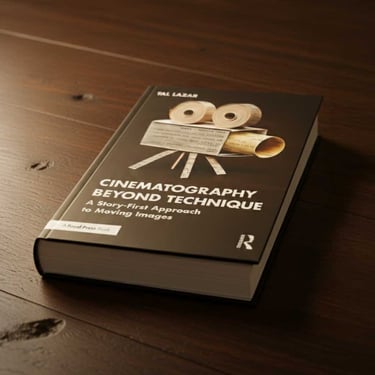Special Support for Educators!
Considering Cinematography Beyond Technique for your course? Get in touch to receive:
An educator booklet with exercise by leading professors.
Reach out to the author directly with your questions.
A free virtual Q&A or guest lecture with the author.
Two sample chapters to help you decide if the book is right for you.
All of the book’s scenes, examples, and resources: ready to use in class.
Inside The Book
Hundreds of examples from films, photography and paintings • guided observation and exercises • practice all techniques learned
1 Visual Language
What makes an image effective in visual storytelling? Discover a new approach to observing and discussing images, and explore techniques for learning through observation and audience feedback.
2 Breaking Down the Script
How does a director prepare to lead a creative collaboration? Learn to read between the lines of the script and bring your unique vision to life within the story.
3 Characters and Perspective
How can a character find their voice in a scene, and how does a filmmaker express their own? Discover the secrets of narrative perspective and practical methods to bring it to life.
4 The Visual Strategy
Transform camera placement into a powerful storytelling tool. Learn how to fully immerse your audience in the experience or allow them to observe it from a distance.
5 Introduction to Lenses
The lens is the only tool a director truly needs to master, as we all have lenses in our eyes. Discover how a lens works and the unique characteristics that can be harnessed to tell a compelling story.
6 Selecting a Lens
Whether it's a wide or long lens, zoom or fixed, or even a specific brand—learn how to differentiate between lenses and choose the perfect one for your scene.
7 The Cinematic Composition
Guide your viewer's attention, highlight key points of interest, and control the illusion of depth. Master timeless techniques to create impactful moving images with speed and precision.
8 Expression with Color
Color has a physical impact on the observer. Learn how to describe color objectively, utilize color contrast in images, and ensure consistent results while protecting your own eyes during observation.
9 Movement and Time
When should the camera move, and when should it remain still? Learn the difference between an edited scene and a long take, and understand how to move the camera with purpose.
10 The Language of Light
Master the fundamentals of lighting design without setting foot on set. Learn how to observe and describe lighting like a cinematographer, and understand its most basic objectives.
11 Practical Lighting
Lead a creative collaboration on lighting without physically handling any lamp. What motivates effective lighting? How can you emulate a light source? Learn and practice the principles of lighting design.
12 The Director and the Cinematographer
From hiring the perfect collaborator to developing a visual strategy resilient to on-set disasters, learn how to lead a visual collaboration in pre-production and on set.


